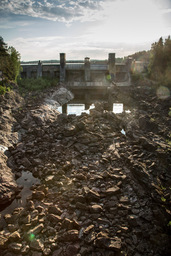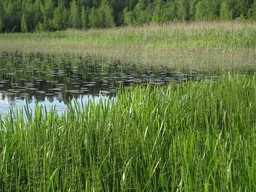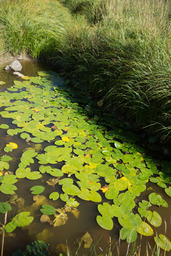17. Water ecosystems must be protected
Contents
17.1 Threats to aquatic environments
In Finland, we live surrounded by water environments. The Baltic Sea surrounds the southern and western coasts of the country. Inland, there are thousands of lakes and ponds. There are also hundreds of rivers, and even more smaller brooks.
However, these aquatic environments are under serious threat of becoming ruined. There are many factors behind this:
- The bodies of water are shallow and contain relatively little water.
- There is a lot of agricultural, industrial, and recreational activity near water environments.
- During the winter, the waters freeze over, preventing organisms from receiving oxygen.
- In spring, nutrients are transported to the bodies of water as the snow and ice melts.

17.2 Human threats to water ecosystems
Human activity poses a number of threats to water ecosystems. The most significant of these threats is eutrophication. Eutrophication is typically caused by excess nutrients from agriculture, which end up in water ecosystems.
Another example of human activity drastically modifying water ecosystem is hydraulic engineering. Dams have blocked the flow of many rivers and harnessed them into energy production.
The use of motorboats has been restricted in many Finnish lakes, as it disturbs many water-dwelling organisms. Many invasive species, such as manna grass ja waterweed, also threaten the equilibrium of water ecosystems.
Environmental toxins, such as the insecticide DDT, have ruined many water ecosystems. These toxins have driven many species to the brink of extinction.
Some Finnish lakes have been troubled by acidification. Acidification is primarily caused by acidic toxins that are spread in rainfall. Nowadays, acidification is not as great a threat as it was some decades before, as the worst emissions from industry and traffic have been somewhat reduced.

Shipping, habitation, traffic and industry all affect the quality of seawater near Helsinki.
17.3 Eutrophication
| Change | Impact |
|---|---|
| Nitrogen and phosphorus end up in the water | The amount of nutrients increases → plants are able to grow better. |
| Increased production of algae | Deterioration of water quality. |
| Cyanobacteria increase | Some cyanobacteria are harmful to health, swimming must be restricted. |
| Increase of floating leaf and aerial shoot plants | Body of water is overgrown with vegetation |
| Algae increase → microorganisms feeding on dead algae increase. |
Increase in predators feeding on zooplankton |
| Algae continue to increase | The water continues to be overgrown by vegetation → the number of aquatic birds decreases. |
| Increased vegetation | The number of dabbling ducks increases. |
| Sediments begin to accumulate on the bottom of the lake | Bacterial decomposition results in higher oxygen consumption → the amount of oxygen in the water decreases → depletion of oxygen → fishes die out. |





